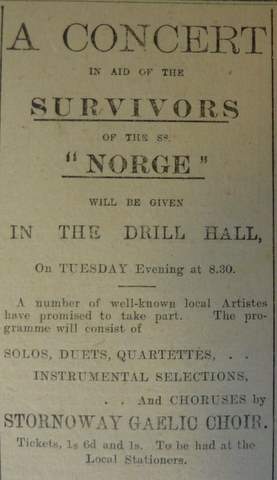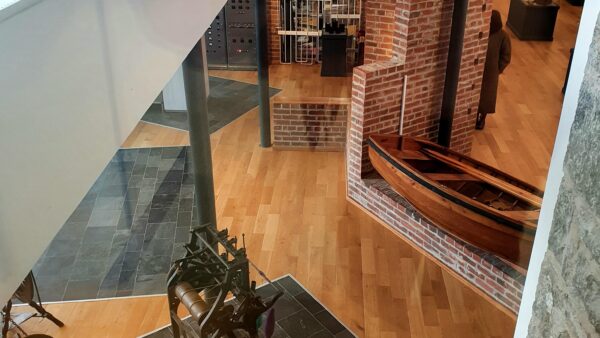
The Norge disaster
On 28 June 1904 the Danish ship SS Norge, which was en route to New York carrying emigrants from Scandinavia and Russia, was wrecked on Rockall. The vessel sank quickly and more than 600 of the 765 people on board were lost. The survivors spent several days at sea on six of the ship’s lifeboats before being rescued. As noted in a minute book held by Tasglann nan Eilean, the survivors were taken to Grimsby, Aberdeen, the Faroes and Stornoway. The majority of those rescued (101 people) were brought ashore at Stornoway.
This disaster preceded the loss of the Titanic by eight years, yet the lessons which could have been learned were not heeded. As with the Titanic, the Norge did not have enough lifeboats to rescue all those aboard, and, due to poor design, not all the lifeboats could be successfully launched.
The events are revealed through a number of sources held by Museum and Tasglann nan Eilean and others.
The Norge was built in 1881 by the Glasgow firm Alexander Stephen & Sons for Belgian clients and was original called the Pieter de Coninck. She was renamed Norge in 1889 when she was sold to the Danish firm A/S Dampskibs-selskabet Thingvalla.

The survivors landed at Stornoway on around 4th July. The town immediately rallied to their aid, providing food, shelter, clothing and medical care. A charity concert was hastily arranged. The survivors were housed in the Poorhouse, Lewis Hospital, the Sailors Home and several private homes in Stornoway.
The minute book entry of the Lewis Combination Poorhouse of September 1904 records:
“During this quarter we had a very busy time with the ship wrecked folk from the ‘SS Norge’ – this having reference to the admission to house on 4th July of 52 men, women and children as some of the survivors from the Scandinavian- American emigrant SS Norge lost at Rockall on 28th June.”

Front row: Trygve Mathisen (2nd from left), Sina Mathisen with Albert on her lap (3rd from left), Sara Pruzansky (2nd from right), Josephine and Ernest Barnhardtson (5th and 4th from right).
(Information re names from ‘Titanic’s Predecessor, The SS Norge Disaster of 1904’; Photograph from Lewis Museum Trust collection held by Museum nan Eilean)

In addition to those lost at sea, there were further losses amongst those in Stornoway as some survivors having made it to land then succumbed to their injuries. Most of those who died were children, as the minute book records:
“Notwithstanding all that love, attention and skill endeavoured to do for the sick and suffering among those strangers, nine of them died while here, 3 girls and 4 boys in the Lewis Hospital and 1 man and 1 girl in the Combination Poorhouse. A boy who had died in the boat before landing was also buried…”
Those lost were interred at Sandwick Cemetery. The cemetery cash book records payments for the lairs, including an entry for one child whose lair was paid for by Provost Anderson.


Captain Gundel later wrote a letter to the townspeople of Stornoway, which was copied into the Poorhouse minute book. In it he thanks the people ‘rich and poor’ for their help and support during the period:
“Allow me to convey the sincerest and warmest thanks to you and all the inhabitants of Stornoway for your kindness, hospitality and goodwill to all of us poor shipwrecked and sick persons. We all feel deeply indebted and thankful. I cannot find words to explain my gratitude to all. Everyone (rich and poor) have done so much, and been so kind to us foreigners. The children and sick have been nursed as careful by your ladies as if they were children of their own. Everyone had a kind word to us. I think no other place in the world would have done what you have done to us. All my life I will think of you with the highest esteem, gratitude and thankfulness. God reward you for all.
With sincerest of high estimation and thankfulness. For the survivors of SS Norge landed at Stornoway.
V Gundel, late Master SS Norge”


Almost 20 years later, in July 1923, the Rector of the Nicolson Institute, W.J. Gibson, visited Denmark on a study trip. In a letter home to his wife, he reported that he had met someone who was aware that the survivors had been brought to Stornoway; the town’s response to the disaster was long remembered.
The full story can be read in Per Kristian Sebak’s excellent book: ‘Titanic’s predecessor: the SS Norge disaster of 1904’ (2004).




